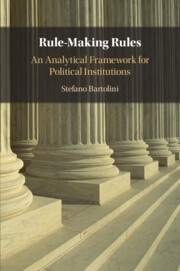4 - What Political Institutions Are
from Part II - On Political Institutions
Published online by Cambridge University Press: 16 June 2022
Summary
In Chapter 4 I discuss the theoretical definition of ‘political institutions’ sketched in Chapter 3, which sets them aside from the other institutions discussed in Chapter 3. Political institutions are norms and rules that transform a set of contradictory instigations to action into a single command; that discipline the struggle to achieve positions that can transform contradictory instigations into a command; that constrain the ruler’s search for generalised and stabilised behavioural compliance in any confined group; and that concern the procedure through which public powers produce private powers (as guaranteed rights), not the concrete outcomes of these procedures. I then distinguish different kinds of norms/rules: norms/rules of conduct versus norms/rules of recognition and norms/rules of conferral. It is argued that political institutions are norms/rules of conferral and are not rules of conduct or of recognition, and that confusion is generated when the types are mixed.
- Type
- Chapter
- Information
- Rule-Making RulesAn Analytical Framework for Political Institutions, pp. 121 - 153Publisher: Cambridge University PressPrint publication year: 2022

